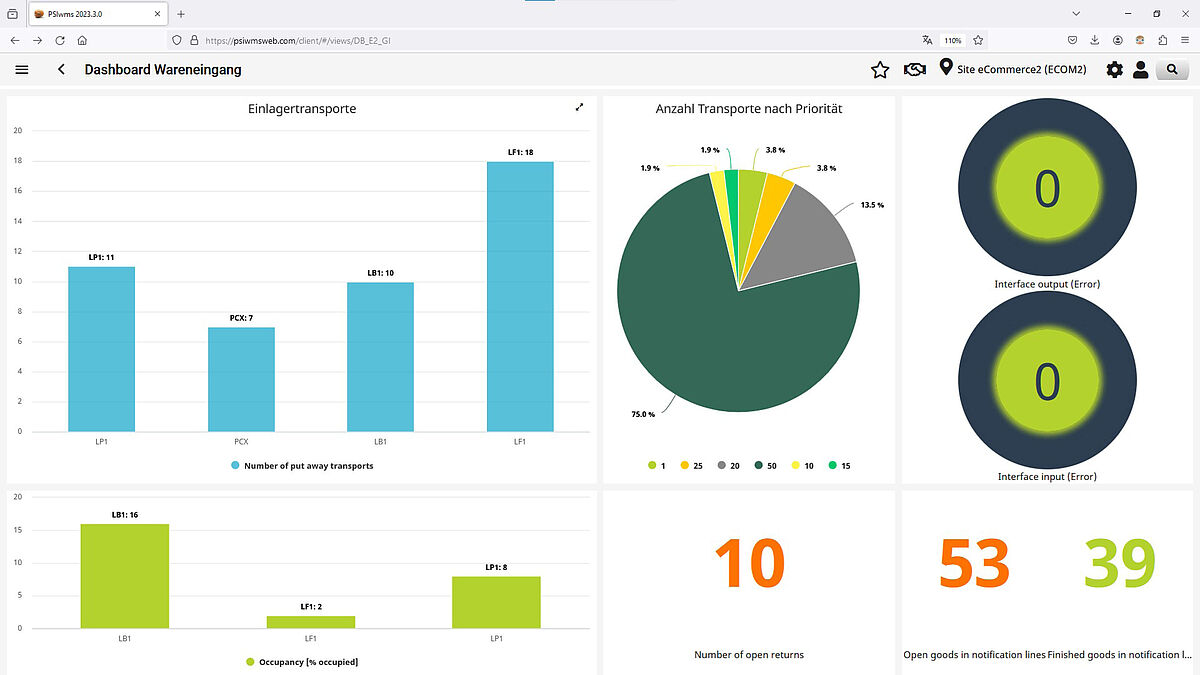
Challenges
Errors in the process or in the software must be detected and rectified. Especially after changes to the warehouse management system (WMS) or intralogistics, tests are essential to ensure that all processes continue to run without any loss of quality.
Automated testing as the basis of agile software development is increasingly coming into focus and replacing manual testing as the dominant concept. This trend will continue in the next years, which is why WMS users should take a look into this test variant.
Avoid errors when making changes in the WMS
The test procedure ensures that all relevant processes (both physical and software-related) continue to function with consistent quality after changes have been made in the warehouse or software.
Keep special processes functional
It also ensures that special processes that are not currently in focus remain functional and can be used in the future.
General conditions
As a user, you configure processes in PSIwms independently, so you should also be able to test them yourself. This requires a particularly intuitive test system that is easy to use. The trend is increasingly moving towards automated testing, which requires the WMS user to perform just a few simple steps. With this method, processes such as bookings or transactions can be simulated automatically.
Manual vs. automated testing
Automated test procedures are particularly suitable for standardized processes. Test cases that run according to the same pattern can be run through in a very short time and the user can run through the entire warehouse cycle of a day. However, it is also possible to check processes manually. There are two variants:
- Scripted procedure: Scripted testing, similar to the automated procedure, is based on a test suit. Here, it is clearly defined which actions the user must perform proactively and in which order. The repetitive nature of the process plays an important role in quality testing. This is the only way to ensure that business processes that were documented in an earlier test case continue to function.
- Exploratory approach: The explorative approach does not define any fixed processes and therefore does not use a test suit. Nevertheless, it is advisable that the users do not start off without a test suit, but first define goals and create a plan to achieve them efficiently.
These manual test procedures will not die out completely, as they are unavoidable for special adaptations to the system, whereas automated tests are best suited for standardized functions and settings. Overall, manual testing will be pushed further and further back in the coming years, as the advantages of automated testing are obvious.
Automated testing at PSI
The creation of test suits has undergone a major transformation in recent years. Sound programming knowledge is no longer as important for their operation as it used to be. The test framework developed by PSI goes one step further and formulates its test suits in the same language as the logistical configuration. If the user learns how to configure processes in PSIwms, he also lays the foundation for creating the test procedures and can carry them out without extensive programming experience.
While tests normally have to be predefined, which involves a lot of work and planning, with PSI they are structured in such a way that not every single process has to be meticulously defined. To test a complete run through the warehouse, it is often sufficient to define the object. This usually includes items and orders with their specific parameters.
Usage scenarios
In an automated test, physical or software-based processes configured in PSIwms are checked for functionality and accuracy. First, cross-departmental test cases, also known as test suits, are defined in the program. The test suits can be used in all logistics areas, whether in incoming or outgoing goods, picking or for high-priority advice notes. Special processes such as complex cross-docking variants are also checked during the process, even though they are used relatively rarely. This screening ensures that all processes function according to plan at all times.

In use at NOSTA
The NOSTA Group, a family-run full-service logistics provider with 800 employees, has been using PSIwms since 2008. The warehouse management system is nowadays used at seven warehouse locations of the Osnabrück-based company. Before the implementation of PSIwms, goods receipts and tests were mainly carried out manually, which cost a lot of time and led to errors and non-transparent inventory documentation and processes. With the automated test tool in PSIwms, NOSTA can now test non-invasively whether and how a new client affects the existing processes before it is added to the warehouse. Potential errors are detected early and precisely and can be eliminated.
PSIwms offers us the opportunity to view the order data and stocks of each individual client at the various locations quickly and easily. Automated testing has become indispensable for us. It has helped us to increase our efficiency. Manual testing is no longer an option for us with today's volume of data.
Time savings through automated tests during WMS implementation
Find out how you can save time thanks to this useful function in PSIwms in our video.
Conclusion
Test procedures are essential to ensure that all processes in PSIwms continue to function even after changes to the software or intralogistics. Automated test procedures are becoming increasingly popular, as predefined applications can be simulated independently. At PSI, test suits can also be created without in-depth programming knowledge, as they are written in the same language as the logistics configuration. A project employee who configures processes can also write tests to ensure this function is sustainable. Manual test procedures, which require proactive interactions by the employee, are therefore becoming less and less important.
Products used

PSIwms
Warehouse management software to manage, control and optimize your intralogistics.
-
Various WMS editions
PSIwms is available in three editions (GO, FLEX and PRO) - customer-oriented, highly flexible and user-friendly for maximum performance.
-
Upgrade as a Service (UaaS)
With UaaS you benefit from continuous, automatic software upgrades that always keep your systems up to date.
-
Software as a Service (SaaS)
The SaaS version is scalable with a flexible pricing model - fast deployment and automatic updates.

PSIwms
Warehouse management software to manage, control and optimize your intralogistics.
-
Various WMS editions
PSIwms is available in three editions (GO, FLEX and PRO) - customer-oriented, highly flexible and user-friendly for maximum performance.
-
Upgrade as a Service (UaaS)
With UaaS you benefit from continuous, automatic software upgrades that always keep your systems up to date.
-
Software as a Service (SaaS)
The SaaS version is scalable with a flexible pricing model - fast deployment and automatic updates.
Questions and answers
Is the manual test a discontinued model?
In the future, process tests will become more and more automated. This approach is perfect for standardized functions and settings. Automated testing is the ideal solution, especially for major updates. The focus here is on repeatable processes.
Manual testing, on the other hand, will become less relevant. But it will not disappear completely, as not all test scenarios can be automated.
Werden bei automatischen Tests Programmierkenntnisse benötigt?
Learning how to configure a product also lays the foundation for creating tests. The test suites are written in the same language as the logistics configuration. So if a customer's project team member can configure processes, they are also able to write tests.


